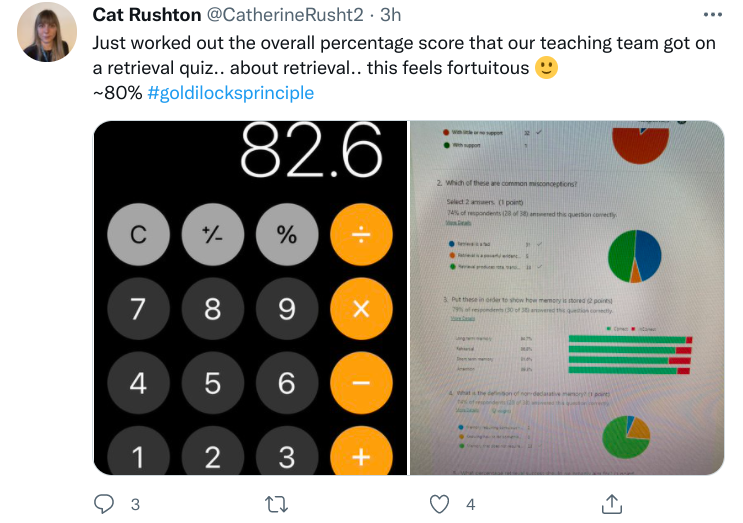This post has been in draft for a few months now however prompted by @CatherineRusht2‘s mention of the “Goldilocks Principle” – I finished and posted it.

Fortuitous indeed.
You get the analogy. Just the “right” amount of difficulty – not too hard but also not too easy. A level of difficult is desirable because they “trigger encoding and retrieval processes that support learning, comprehension, and remembering.” Of course, the level of difficulty that is optimal, therefore, will vary with the degree of a learner’s prior learning. Cue the expected Robert Bjork reference – (1994b).
Right – so just two points to add. Spacing and Motivation. The desirable difficulty of spacing, fits hand in glove with retrieval – see Latimer, Peyre and Ramus (2021). In case you were wondering, Catherine replied that the retrieval practice test was taken a week after the CPD.
Second, Finn (2020) provides a convincing case that bringing desirable difficulties into the real world of education requires addressing the motivational factors too. Of course it does. Convincing learners to introduce desirable difficulties is, ironically, difficult. Not only that, Finn points out past academic experiences – and achievements, or lack thereof – provide a basis for their expectations and goals. Is that a roundabout way of saying learner “engagement?”
Swingin’ back around success or failure rates
I have always referred to high success rates, maybe I will start to referred to failure rates.
When we learn / encode new things, be it retrieval practice CPD or Macbeth plotlines, coastlines or datelines we sometimes fail. But what’s the right amount of failure?
Catherine mentioned the that there is something of a “sweet spot” when it comes to learning. Using the slightly fancier term, where lies the “zone of proximal difficulty?” Where lies learnings equivalent of Bermuda Triangle?
“…you get 100% right all the time and there’s nothing left to learn. If I give really hard examples, you’ll be 50% correct and still not learning anything new, whereas if I give you something in between, you can be at this sweet spot where you are getting the most information from each particular example.”
Prof Robert Wilson
Wilson and his colleagues at Brown University, the University of California, Los Angeles and Princeton came up with the so-called “85% Rule.” After a series of machine-learning experiments in which they taught computers to classifying different patterns into one of two categories: classifying photographs of handwritten digits as odd versus even numbers or low versus high numbers. The computers learned fastest in situations in which the difficulty was such that they responded with 85% accuracy. Okay, it is computers you say – but this calculation aligns with studies of animal learning too.
🥡 Takeaway
This paper encouraged me to rethink what is desireably difficult.
Second, I continue to reflect on two different phases of retrieval. Retrieval as learning / encoding and retrieval practice as relearning. Does the sweet spot shift?
Achievement (success) and motivation are reciprocal. Does a low failure rate accelerate motivation?
Is 85% for simple tasks, 2 categories, true / false?
Pitching questions or designing activities where 85% of the class were success seemed to encourage the class to tackle more difficult tasks.
Does prior domain confidence matter?
Over to you – of course designing lessons or tests, or posing questions even, where 85% of the pupils know the answer is know easy task.



Pingback: Motivated by motivation (Intro) – Edventures
Pingback: Adapting quizzing: perception of cognitive load #retrievalpractice – Edventures